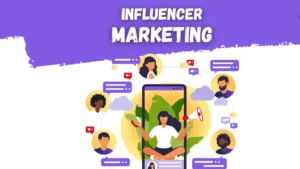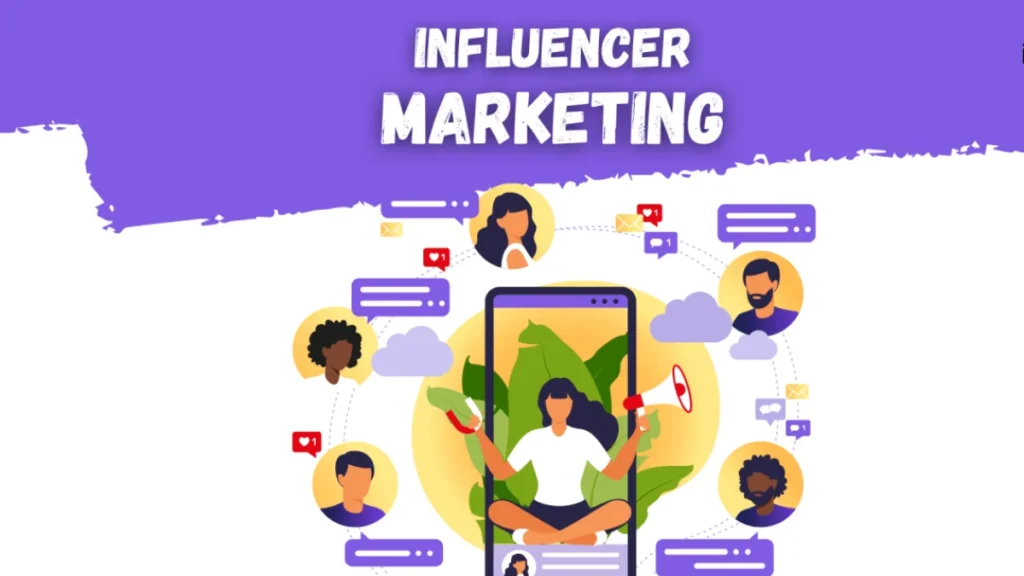In a world dominated by digital media, influencer marketing has become one of the most powerful tools for businesses. By partnering with influencers, brands can tap into niche audiences, build trust, and engage customers more effectively than traditional advertising methods. This guide will walk you through everything you need to know about influencer marketing, from types of influencers to best practices and campaign strategies.

Social media platforms used in digital marketing
| Platform | Key Features | Target Audience |
| Extensive ad targeting, varied content formats |
Broad demographic, all ages
|
|
| Visual content, Stories, Reels, influencer focus |
Millennials, Gen Z, lifestyle brands
|
|
| Real-time engagement, trending topics, hashtags |
News junkies, professionals, Gen Z
|
|
| B2B networking, professional content, job postings |
Professionals, B2B marketers
|
|
| TikTok | Short-form videos, viral trends |
Gen Z, younger audiences
|
| Visual discovery, DIY, and inspiration boards |
Mostly female users, DIY enthusiasts
|
|
| YouTube | Long-form video content, ads, tutorials |
All ages, diverse interests
|
Top influencer marketing tools for 2024:
| Tool | Features |
| Tagger by Sprout Social |
Data-powered social intelligence for finding and managing influencers.
|
| Brandwatch |
Extensive influencer database with tools for measuring campaign success.
|
| Upfluence |
Comprehensive platform for influencer discovery, relationship management, and campaign tracking.
|
| Creator.co |
Manages influencer relationships and tracks campaign performance.
|
| NeoReach |
Focused on influencer marketing analytics and campaign management.
|
What is influencer marketing?
Influencer marketing is a type of social media marketing that leverages endorsements and product mentions from individuals with a dedicated social following. Unlike traditional celebrity endorsements, influencers are often more relatable, and their audiences trust their opinions and recommendations. Whether it’s a beauty guru on Instagram or a fitness vlogger on YouTube, influencers hold the power to sway purchasing decisions within their communities.
Influencer marketing using your website
Create an Influencer Marketing Page: Highlight collaborations and success stories.
Use SEO: Optimize content with keywords related to influencer marketing.
Feature Collaborations: Showcase influencer content on your site.
Implement Affiliate Programs: Set up commissions for influencers driving traffic/sales.
Create a Resource Center: Offer guides and best practices for influencers.
Utilize Blogging: Write case studies on campaign metrics and outcomes.
Incorporate UGC: Display user-generated content from influencers.
Use Contact Forms: Provide an easy way for influencers to inquire about collaborations.
Monitor Analytics: Track the performance of influencer content on Event your site.
Promote on Social Media: Share influencer-related content to increase reach.
Read more: The Ultimate Guide to Social Media Marketing: Powerful Strategies for Success
Types of Influencers
Choosing the right influencer is crucial to your marketing campaign’s success. Here’s a breakdown of the main types of influencers based on audience size:
- Mega-Influencers: These are celebrities with millions of followers, often reaching a broad audience.
- Macro-Influencers: With around 100k to 1 million followers, these influencers can offer a large reach with lower costs compared to mega-influencers.
- Micro-influencers: Popular in niche markets, micro-influencers typically have between 10k and 100k followers.
- Nano-Influencers: These influencers may have fewer than 10k followers but boast highly engaged, loyal audiences.
Each type offers different benefits, so selecting the right one depends on your campaign goals and budget.
Read more: SEO strategy
Why Brands Should Use Influencer Marketing
Brands across industries are using influencer marketing because it offers unique advantages:
- Increased Credibility: Audiences trust influencers’ recommendations more than brand advertisements.
- Expanded Reach: Influencers help brands connect with new demographics.
- Higher Engagement Rates: Content created by influencers tends to receive higher engagement, thanks to their connection with their audience.
- Better Return on Investment (ROI): Influencer marketing is generally more cost-effective, especially when working with micro and nanoinfluencers.
- SEO and online presence boost: collaborations with influencers can increase backlinks and social signals, indirectly boosting your website’s SEO.
Types of Influencer Marketing Campaigns
There are various ways to structure an influencer marketing campaign. Here are some popular types:
- Sponsored Content: Brands pay influencers to create posts or videos about their products.
- Product Reviews and Unboxing: Influencers review products, providing honest opinions that can build trust.
- Affiliate Marketing: Influencers share unique links that give them commissions on referred sales.
- Giveaways and Contests: Engage audiences and encourage followers to participate actively.
- Brand Ambassadorships: long-term partnerships where influencers consistently promote a brand over time.
- Takeovers: Influencers “take over” a brand’s social media account for a day, creating content and engaging directly with the brand’s audience.
How to Choose the Right Influencer for Your Brand
Selecting the right influencer involves more than follower count. Here are key factors to consider:
- Audience Alignment: Ensure the influencer’s audience matches your target demographic.
- Engagement Rate: High engagement often signals that the influencer has an active, interested audience.
- Content Quality: Influencers with a unique style and quality content often drive better results.
- Authenticity: Choose influencers who align with your brand values and create genuine, relatable content.
- Budget: Decide on the campaign budget and find influencers within that range to ensure you’re getting good value.
Choosing the right influencer:
Define Goals and Audience: Clarify campaign objectives and target demographics.
Choose Influencer Type:
- Nano (1K-10K): high engagement, niche focus.
- Micro (10K-50K): authentic, cost-effective.
- Macro (50K-1M): Broad reach without celebrity costs.
- Mega (1M+): large audiences, high-budget campaigns.
Evaluate Engagement & Authenticity: Look for genuine engagement over high follower counts.
Analyze Content Quality: Ensure content style aligns with your brand’s voice.
Check audience demographics: Match the influencer’s audience to your target demographic.
Review Past Campaigns: Assess previous partnerships for performance and brand fit.
Use Influencer Tools: Tools like Tagger and Upfluence provide valuable influencer data.
Setting Up a Successful Influencer Campaign
A successful influencer marketing campaign starts with clear planning. Here’s a step-by-step process:
- Define Campaign Goals: Are you aiming for brand awareness, engagement, or direct sales?
- Budget Planning: Allocate funds based on influencer size and campaign duration.
- Create a Campaign Brief: Outline goals, deliverables, and any specific content requirements.
- Outreach and Negotiation: Reach out to influencers, discuss rates, and finalize agreements.
- Content Review and Approval: Ensure the influencer’s content meets your brand standards.
- Launch and Monitor: Publish content and track performance.
Tracking and measuring success
For an effective influencer marketing strategy, it’s essential to track the campaign’s impact. Here are some key metrics to monitor:
- Engagement Rate: Likes, comments, and shares show how well the content resonated.
- Reach and Impressions: Number of unique viewers who saw the content.
- Conversion Rate: Number of users who made a purchase or took the desired action.
- Return on Investment (ROI): Compare revenue generated to the cost of the campaign.
- Traffic and New Followers: Track increases in website visits and social media followers.
Influencer Marketing Best Practices
To make the most of influencer marketing, follow these best practices:
- Prioritize Authenticity: Authentic content drives more engagement and builds trust.
- Encourage Creative Freedom: Let influencers bring their own style to the campaign.
- Follow Disclosure Guidelines: Be transparent with #Ad or #Sponsored tags as per advertising regulations.
- Build long-term relationships: Long-term partnerships often yield better results than one-off campaigns.
- Stay Updated with Platform Trends: As platforms evolve, so should your influencer marketing strategies.
key influencer marketing strategies for 2024:
| Strategy | Description |
| Focus on Micro and Nano Influencers |
Target influencers with 1,000–50,000 followers for higher engagement and cost-effectiveness.
|
| Embrace Long-Term Partnerships |
Build lasting relationships for authentic, consistent brand messaging.
|
| Prioritize Video Content |
Invest in short-form video on platforms like TikTok, Instagram Reels, and YouTube Shorts.
|
| Leverage AI and Data-Driven Decisions |
Use AI for influencer discovery, campaign tracking, and content personalization to enhance effectiveness.
|
| Focus on Authenticity and Transparency |
Encourage influencers to provide genuine opinions to build trust with their audience.
|
| Utilize User-Generated Content (UGC) |
Increase trust by having influencers create relatable, authentic user-generated content.
|
| Explore Niche and Hyper-Personalized Campaigns |
Target specific audience segments with tailored campaigns to boost engagement.
|
| Monitor and Measure Performance |
Track metrics like engagement, reach, and conversions to assess campaign success and make adjustments.
|
Common Challenges in Influencer Marketing
While effective, influencer marketing isn’t without its challenges.
- Finding the Right Influencer: It can be tough to balance reach, relevance, and authenticity.
- Measuring ROI: Calculating the exact ROI can be challenging, especially for indirect metrics like brand awareness.
- Managing Campaign Costs: Influencer costs vary widely, so it’s important to align spending with your marketing goals.
- Dealing with Fake Followers: Some influencers may inflate their numbers, so use tools to verify audience authenticity.
Steps to Success in Influencer Marketing
1. Define Your Goals
- Determine what you want to achieve (e.g., brand awareness, sales, engagement).
- Clear objectives will guide your strategy and help measure success.
2. Know Your Audience
- Identify your target audience and understand their interests, behaviors, and preferred platforms.
- This knowledge will help you choose the right influencers.
3. Identify the Right Influencers
- Look for influencers whose audience aligns with your target market.
- Consider micro and nanoinfluencers for higher engagement rates.
4. Craft a Compelling Brief
- Provide influencers with a clear, detailed brief outlining your goals, key messages, and any specific requirements.
- Ensure it’s easy for them to create authentic, aligned content.
5. Build Long-Term Relationships
- Focus on long-term partnerships rather than one-off collaborations.
- This fosters authenticity and allows influencers to better understand and represent your brand.
6. Leverage video content
- Prioritize video content, especially on platforms like TikTok, Instagram Reels, and YouTube Shorts.
- Videos are more engaging and shareable.
7. Monitor and Measure
- Use influencer marketing tools to track performance (e.g., engagement rates, reach, conversions).
- Analyze the data to understand what’s working and refine your strategy.
Future of Influencer Marketing
As social media continues to evolve, so does influencer marketing. Here are a few trends shaping its future:
- Rising Popularity of Nano-Influencers: Brands are increasingly drawn to smaller influencers with highly engaged audiences.
- Video Content Dominance: Short-form video content on platforms like TikTok and Instagram Reels is taking center stage.
- AI and Virtual Influencers: AI influencers are emerging, allowing brands to create and control virtual brand ambassadors.
- Influencer Marketing in the Metaverse: VR and AR offer new ways to interact with influencers in virtual worlds.
- Increased Regulation: Expect more transparency requirements as the industry matures.
Conclusion
Influencer marketing is one of the most impactful strategies for brands looking to grow their presence and build strong connections with audiences. By choosing the right influencers, setting clear campaign goals, and measuring success, you can maximize your ROI and create powerful brand stories that resonate. Whether you’re new to influencer marketing or looking to refine your strategy, staying authentic and adaptable will keep your brand ahead of the competition in 2024 and beyond.

